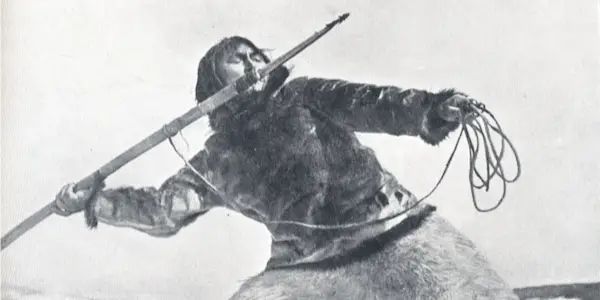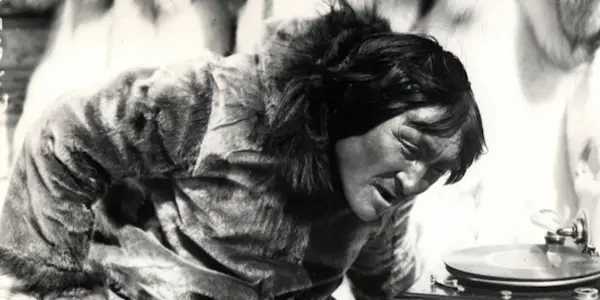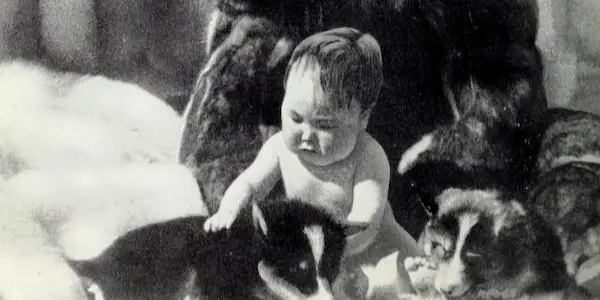A Century In Cinema: NANOOK OF THE NORTH (1922)

Jules Caldeira is an Associate Editor for Film Inquiry based…
Welcome to A Century in Cinema, the semimonthly column where I’ll be discussing films from a hundred years ago, the impact they had at the time as well as historically, and how they hold up today. Whether we’re covering timeless classics or obscure gems, follow along as we continue to explore…a century in cinema! WARNING: Hundred-Year-Old SPOILERS ahead!
Since their inception, documentaries and their predecessor’s “actualities” have shown audiences slices of life or moments in time that we might not otherwise experience. These can not only be domestic films but might also provide a glimpse into the beauty of nature or other cultures that we may never see outside of the silver screen.

In 1896, the Lumière Brothers astonished crowds with The Arrival of a Train at La Ciotat Station, which by our standards is as simplistic as its title, but was groundbreaking in its day. Twenty-six years later, after the release of many, many actualities and travelogues – also known as “scenics” – came Robert J. Flaherty’s Nanook of the North, the first feature-length “documentary” to be a box-office success.
The Vexing Veracity of Vérité
I use “documentary” in quotes because of the widely known issue of Flaherty’s staging scenes to get the desired shots for this film, rather than filming life as it happens. Nanook, the titular Inuk that serves as our indigenous hero, was actually named Allakariallak, and the family we follow was not his own. The women on-screen were not his wives, but rather common-law wives of Flaherty’s, and the children were certainly not theirs. All of the interior igloo shots had to be staged because a functioning igloo could not be built large enough to accommodate the tall camera, and in these scenes, you can see much more light coming in due to the open portion of the igloo. Although Allakariallak regularly hunted with a gun, Flaherty opted for him to use a harpoon to show the hunting methods of his ancestors. There’s a scene played for laughs where the white operator of the trading post shows Nanook a gramophone. Nanook laughs in wonderment as he hears the seemingly disembodied voice and even tries to bite the record because “he doesn’t know what a gramophone is! Isn’t that funny?” In truth, Allakariallak lived in a contemporary home, was quite familiar with what a gramophone was, and the whole sequence was scripted for the film.
While nowadays it’s not uncommon to question the truthfulness of a documentary or whether it’s showing the “whole picture,” for the oldest popular documentary to not truly be a documentary is a frustrating paradox. However, the film was indeed filmed on the Ungava Peninsula in Northern Quebec, and I suppose we can be thankful that Flaherty truly did work with the Inuit people and didn’t follow D.W. Griffith’s example in The Birth of a Nation and cast white people as Inuits. Rather than starting as a script or a studio pitch, the idea for this film came about organically.

In 1910, Flaherty was hired as part of a surveying expedition to the Hudson Bay for the Northern Canadian Railway. After learning about the land and the native peoples who inhabited it, in 1913 he took a course at Eastman Kodak to learn the basics of filmmaking and spent the next few years shooting thousands of feet of film of the lives and practices of the Inuit people. His early test screenings were met with positive reactions, but in 1916 Flaherty dropped a lit cigarette on the highly flammable nitrate film stock and all the footage was lost. Forced to start over, Flaherty shifted the focus to just one Inuit family and spent the next few years seeking funding for the excursion, which he found in Revillon Frères, a French fur company. Shooting resumed from August 1920 to August 1921, with Allakariallak cast as the lead because he was a celebrated hunter of the Itivimuit tribe.
An Entertaining Product of Its Time
Even though he is playing a character in Nanook that is a generation or two behind his own experiences, Allakariallak’s performance is nonetheless engaging. Because there were no stuntmen or special effects involved, his physicality is that much more impressive, from kayaking around mounds of ice to actively hunting and butchering a walrus and seal to building an igloo. Regardless of these events being staged, they still took a tremendous amount of work and experience that should be noted and commended. When Nanook is attempting to harpoon a seal through the ice and is repeatedly dragged back and forth in a tense tug-of-war, you truly do feel invested in his well-being and success. Scenes of Nanook teaching his son to shoot a bow and arrow and watching the children eat castor oil after a big meal also play with genuine humor and warmth. A highlight of these sequences is watching the youngest child sitting with baby huskies, which is still adorable a hundred years later and proof that some things truly are timeless.
When looked at as a work of fiction rather than a documentary, Nanook is a gripping tale of a man and his family working against the elements to survive and is still engaging today. The cinematography, with its wide shots of the snowscape and bodies of water that set the precedent for nature documentaries to come, is quite gorgeous. If Flaherty had marketed this as a fictionalization of a bygone generation, or as preservation of Inuit traditions or customs, I think that this film still could have done well. However, I’m sure with audiences of 1922 it was enticing to see Nanook and his family and believe that those are true and accurate depictions of Inuit people as they are now, and they likely loved the idea of getting this window into a world they’ll never see for themselves.

Aside from the fictionalization and staging of action and all the other issues that make this “documentary” less so is the ever-present concern of how the Inuits themselves are portrayed. While Flaherty seemingly professes admiration and respect in the title cards – including statements such as “This experience gave me an insight into their lives and a deep regard for them.” – his decision to portray Nanook and his family as absent from any form of modernization and ignorant of the ways of the whites is a dichotomy that I don’t think was necessary to make an interesting story. It was tense and thrilling enough to watch them hunt and wrangle a giant walrus, having a gun instead of a harpoon wouldn’t have dampened the suspense all that much. Watching a man and his family build an igloo from the ground up is interesting no matter how you look at it, and they could have been wearing the contemporary clothing they normally would instead of sealskin boots and it wouldn’t have taken away from the entertainment. Hell, someone could build an igloo by hand on TikTok right now and I’d watch it repeatedly. Just as long as they put the ice block window in there too.
Conclusion:
This film is included on the list of 1001 Movies You Must See Before You Die, and for a good reason. For better or for worse, it’s had a major impact on the history of cinema and documentaries as a whole. Whether it’s for a film history course, or if you’re a film buff who’s working through cinematic milestones, Nanook is worth your time. At best, if you can view it as purely a work of fiction, you’ll find a silent film with some great visuals as well as moments of tension and suspense intermingled with instances of warmth and humor. At worst, you’ll get the references made in the “Kunuk Uncovered” episode of Documentary Now!
Have you seen Nanook of the North before? Does its controversy make the film more or less interesting? Let us know what you think in the comments!
Nanook is available to stream on HBO, Roku, Tubi, Kanopy, or Plex, as well as on Youtube.
Watch Nanook of the North
Does content like this matter to you?
Become a Member and support film journalism. Unlock access to all of Film Inquiry`s great articles. Join a community of like-minded readers who are passionate about cinema - get access to our private members Network, give back to independent filmmakers, and more.
Jules Caldeira is an Associate Editor for Film Inquiry based in Sacramento, CA. He's a drummer, part-time screenwriter, and full-time Disney history nerd who can be found on social media when he remembers to post, and can be contacted at [email protected].













